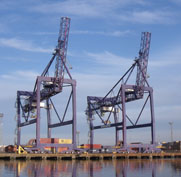Brazil topped the list of countries suffering from heightened cargo theft risks, according to the latest Global Supply Chain Security and Business Continuity Risk Index report from BSI Supply Chain Services and Solutions. Venezuela and Germany came next.
The report showed that cargo theft continued to have a significant impact on trade globally, but highlighted that several countries were particularly affected. In Brazil, Rio de Janeiro saw its highest rate of cargo theft in the last 23 years in 2015, with 7,225 incidents taking place – a 23 per cent increase. Likely reasons for this include the severe impact of Brazil’s overall economic crisis in Rio, and the increased law enforcement efforts in Sao Paulo, traditionally the leading area for theft in Brazil, driving a shift in more organised crime to Rio.
With established and well organised ‘fencing’ networks in place, thieves have been able to target a range of product types, covering everything from food and beverages to cigarettes, electronics, pharmaceuticals, according to the researchers.
This increase in theft forced companies to relocate or adopt extra, costly security measures, with figures showing cargo transportation companies in Rio de Janeiro devoting an average of 15-20 per cent of their budget to security measures. The rate of increase in theft is continuing into 2016 due to new gang activity in the Rio area and the movement of some gangs from Sao Paulo. Initial estimates suggest that theft increased by another 11 per cent in the first quarter of 2016.
Similarly, in Venezuela, the worsening political and economic situation has continued to impact the availability of food and basic necessities. This in turn has led to an increase in looting and cargo truck hijackings of typically low-valued goods like rice, water, flour and liquor. In Aragua State for example, the rate of cargo theft has increased by 500 per cent. The data shows thieves are using violence and tactics that are more frequently reserved for high-value shipments rather than loads of food, further impacting the scarcity of goods as cargo truck drivers refuse to transport them.
Daring vehicle shipment thefts have become increasingly commonplace in Germany. The figures show increases in slash-and-grab and full-load thefts, with particular routes around the main cities and near borders being the most severely affected. Earlier this year, authorities disrupted a group suspected of stealing more than 100 cargo trucks across Germany since 2013. Separately, a group based in Lodz, Poland was apprehended and accused of stealing at least 60 fully-loaded cargo trucks in Berlin, Brandenburg, and Saxony over nearly two years. The statistics show that Saxony-Anhalt saw more than twice as many slash-and-grab incidents in first half 2016 compared to first half 2015.
Across 2015 BSI recorded 319 supply chain terrorism attacks. The figures showed that the proportion of supply chain attacks compared to all terrorism attacks increased 16 percent, and attacks were recorded in a record 33 countries, 38 per cent more than the previous year.
The report found that terrorists targeted a wider range of industries than ever. Attacks on agriculture and food and beverage targets more than tripled since 2013, and attacks on industrial and manufacturing materials, metals, and pharmaceutical cargo more than doubled.
Jim Yarbrough, Global Intelligence Program Manager at BSI said: “Companies have always faced a wide range of challenges to their supply chain, but these latest figures indicate just how severe the impact of violent theft can be. These events are creating extreme levels of risk for organisations, both directly affecting the bottom line and disrupting the supply chain in ways which, if not tackled, could do serious harm to a company’s hard-earned reputation.
“We know that for every shipment stolen, delayed, contaminated or destroyed, the cost to the end-consumer is raised. For exports this hurts competitiveness, undermines productivity and risks jobs; for imports it raises the cost of living for each and every citizen.
“These organised gangs of thieves will always look for new ways to seize goods, so the ability to quantify and mitigate supply chain risks throughout the entire lifecycle is paramount. Understanding the risks, where they exist, and how likely they are to occur will help organisations minimise the delays, costs, and dangers that can result.”
Data
The 2016 Supply Chain Security and Business Continuity Risk Index report is based on data from BSI’s Supply Chain Risk Exposure Evaluation Network (SCREEN) which provides continuous evaluation across 22 proprietary risk factors and 204 countries, for a picture of the changing global threat landscape and how this varies by country, continent and industry sector.









